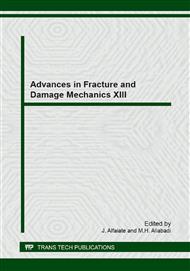p.97
p.101
p.105
p.109
p.113
p.117
p.121
p.125
p.129
Effect of Acid Treatment on Mechanical Performance of Polyvinyl Alcohol/Halloysite Nanocomposites
Abstract:
Halloysite is one of clay minerals (a new family of crystalline aluminosilicates), and has a nano-tubular structure similar to carbon nanotubes. The typical sizes of the halloysite are 50 nm in outer diameter, 15 nm in inner diameter, and 500-1000 nm in length. This paper deals with mechanical properties of PVA/halloysite nanocomposite films which were fabricated by a casting method. Sulfuric acid surface treatments were performed on halloysite to improve its interfacial adhesion bonding between halloysite and PVA polymer matrix. The effect of acid surface treatment on the mechanical performance was also examined. In the case of PVA/untreated-halloysite composites, the tensile strength was decreased; on the other hand Young’s modulus was increased compared with those of neat PVA. It was found that the sulfuric acid treatment time played an important role in the mechanical performance of the PVA/halloysite nanocomposites.
Info:
Periodical:
Pages:
113-116
Citation:
Online since:
September 2014
Authors:
Keywords:
Price:
Сopyright:
© 2015 Trans Tech Publications Ltd. All Rights Reserved
Share:
Citation:


